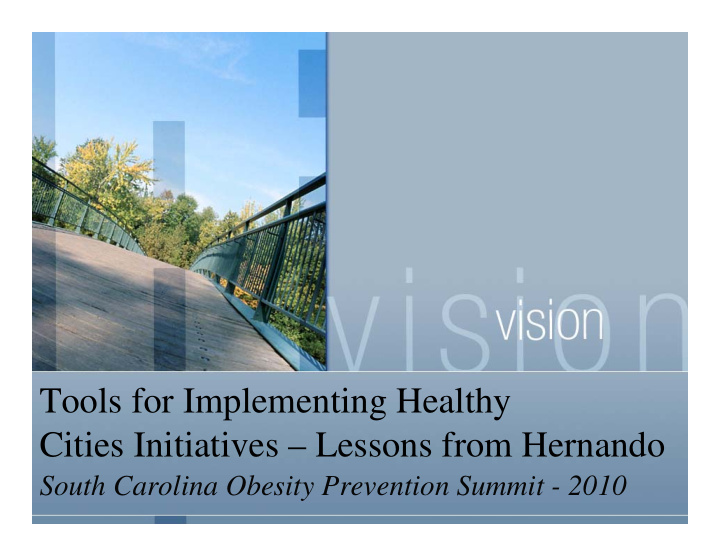



Tools for Implementing Healthy Cities Initiatives – Lessons from Hernando South Carolina Obesity Prevention Summit - 2010
Chip Johnson, Mayor of Hernando, MS Has become a spokesperson for what local governments can do to improve the health of residents. Helped Michelle Obama kick off her Let’s Move campaign at the White House earlier this year. Has spoken to many state Obesity conferences including Missouri, Mississippi and Arkansas. Spoke at the IOM/UK Department of Health conference in Washington.
Introduction “I am the mayor of a city in the fattest state in the nation, in a nation that is the fattest in the world. We are in the business of protecting the health, safety and general welfare of the community (think water, sewer, fire protection and law enforcement), so why shouldn’t we do what is necessary to prevent illness and premature death. And since most problems are more effectively solved at the local level, it is incumbent upon communities to create the right environment for Improving the health of its citizens.”
What constitutes a Healthy Community? Clean air, including Personal safety freedom from second Inspiring civic spaces hand smoke in public Secure income places Education/Life long Clean water learning A sustainable Good social support ecosystem Positive health status Ability to exercise – Good access to fresh, good access to walking unpackaged foods and biking for Available medical recreation and services transportation, and easily accessible parks
What you should have in your toolbox Good partnerships. Effective city policies & ordinances. Passion for helping citizens be healthier! An effective team.
Good Partnerships Community Foundation for Northwest Mississippi – goal of healthy citizens/grant writers Local school district – shared use of recreation facilities. Scouts and youth groups – Girl Scouts in Hernando conducted a sidewalk inventory. Grant making agencies- RWJ, others County or regional trails/greenways group Land Trust Other health-oriented organizations – health department, healthy congregations initiatives, regional health councils, Safe Kids DeSoto County; “Get a Life”, etc. Local, state and national bicycle and walking advocates. Local businesses
Effective City Policies and Ordinances Exactions from land developers for open space. Requirement for sidewalks in ALL developments, residential, commercial, industrial and institutional (new and renovations) Land Conservation Ordinances help protect beneficial tree canopy. This mitigates erosion/sedimentation = clean water and air. Clean Indoor Air Ordinance City-improved sidewalks
Effective City Policies and Ordinances Playful Cities designation two years in a row – only city in Mississippi to gain this recognition Making good use of grants. Permit narrower streets; bring buildings closer to the street for a safer and more attractive walking environment
Passion for Helping Citizens be Healthier Don’t force; reduce barriers to healthy lifestyles and encourage! Focus on the future – children. Don’t stop talking about it. Use every avenue available.
An effective team All city departments should be working toward the same goal Parks and Recreation Law Enforcement Planning Engineering
Why having a good built environment is so important What it means: “The physical structures and infrastructure of communities” (Prevention Institute, 2004) Purpose Creating trails, walkways, playgrounds, parks and roadways which: Encourage walking and biking Calm traffic speeds Make communities more accessible Lessen the need for automotive transportation
What we did to help change the built environment Adding/Repairing sidewalks Adding bike lanes Requiring sidewalks in all new and renovated developments Creating Crosswalks Allowing narrower streets Added/cleaned up new green spaces and parks Developed Design Standards that help improve the aesthetics of the community – making walking a biking a much more pleasant activity Studying adoption of a “complete streets” policy
Promote Exercise “If you build it, they will come.” Field of Dreams Positive factors associated with walking: Aesthetic attributes Convenience (Sidewalks, trails) Accessibility (Proximity to destination) Perceptions about traffic and busy roads
Pedestrian Injury What factors contribute to high rates of pedestrian injury? Lack of Crosswalks The most dangerous areas for walkers are newer, sprawling, southern and western communities where automobile transportation systems are the primary focus. Surface Transportation Policy Project, 2000
Pedestrian Injury What factors contribute to high rates of pedestrian injury? Traffic Volume The risk for pedestrian injury increases with traffic volume Children living in high volume neighborhoods are 13 times more likely to be injured Roberts et al., 1995
Hernando Healthy Community Initiatives Safe Routes to School project Repair of crumbling sidewalks/accessible to the handicapped Helped develop the Hernando Farmers Market Passage of Clean Indoor Air Ordinance Striped bike lanes Participate in DeSoto Greenways Project and the North Mississippi Land Trust Participate in the Ozone Action Committee Complete Streets Policy Mandatory helmet use for youth
Hernando Healthy Community Initiatives Adding parklands and recreational programs Initiated a Community Garden Requires sidewalks and open space in new and renovated developments Subscribes to Smart Growth principles
Recommend
More recommend